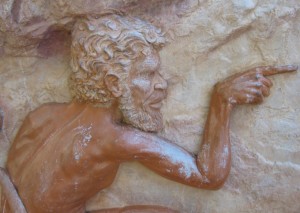Tianchuang – Heavenly Window – Small Intestine 16
 I am currently rewriting the manual for my Five Element Acupressure courses. In doing so, I am making a change to one of the points in the palette of 50 points introduced in Level 1. For over 30 years I have been practising and teaching the basic neck release which I learned in the first acupressure class I took in 1985. One of these points, known as the Extra Neck Point, is not a meridian point, and serves as a kind of surrogate for the many other meridian points in the neck. The change I am making is to replace the extra neck point with the meridian point that is anatomically closest to it. This is Small Intestine 16, Tianchuang (Heavenly Window).
I am currently rewriting the manual for my Five Element Acupressure courses. In doing so, I am making a change to one of the points in the palette of 50 points introduced in Level 1. For over 30 years I have been practising and teaching the basic neck release which I learned in the first acupressure class I took in 1985. One of these points, known as the Extra Neck Point, is not a meridian point, and serves as a kind of surrogate for the many other meridian points in the neck. The change I am making is to replace the extra neck point with the meridian point that is anatomically closest to it. This is Small Intestine 16, Tianchuang (Heavenly Window).
The Small Intestine meridian is the go-to meridian for neck and shoulder pain, so it is appropriate to choose the SI point in the middle of the neck. It fits well with two other SI points of the neck and shoulders release, SI 10 and SI 11. It treats neck pain, shoulder pain which radiates to the neck, and stiffness of the neck which causes difficulty in turning the head to the side. Also at the physical level, Tianchuang treats throat pain, loss of voice, lockjaw, deafness, tinnitus and ear pain.
This point is also important as one of the category of points known as the Windows of the Sky, or Windows of Heaven. (The tian part of the name means heaven.) Modern TCM texts tend to prescribe these points to clear congestion in the sense organs, interpreting tian as a reference to the head, rather than anything mystical or spiritual; and disorders where the Qi of the head is in disharmony with the Qi of the body.
Five Element practitioners have come to regard these Windows of Heaven points as also having a deeper psyhoemotional, or even psychospiritual effect. When a person has lost connection to True Nature, that which transcends the body and the small self, then these points are called for. By ‘opening the window’, the client is supported to see beyond the obscurations that have clouded his view. Each Window point is used in the context of the issues of its corresponding official. The primary function of the Small Intestine official, the Sorter, is to sort the pure from the impure. The small intestine organ itself sorts the nutrition from the waste of the food we eat. At a higher level, if we are unable to sort out what is good for us at emotional, psychological and spiritual levels, then Tianchuang can help. Ultimately, the Sorter’s role is to protect the Heart, Emperor of the kingdom. A healthy Sorter knows what is good for us and can therefore be let into the inner sanctum, and what is not good for us and needs to be kept out.
Location of Small Intestine 16
At the back border of the sternocleidomastoid muscle, at the level of the laryngeal prominence (Adam’s apple). If you turn your head to the left against resistance, the muscle on the right side of the neck becomes prominent.



